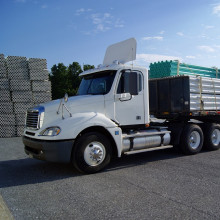Marco got in touch after his truck tipped over on the motorway. He wanted to know what speed the wind would need to be blowing at to cause this, so he knew when to stop driving in the future. Rosalind Davies spoke to Zephyr Penoyre, a PhD student at Columbia State University, to find out the answer.
In this episode

00:00 - What wind speed will blow my truck over?
What wind speed will blow my truck over?
This time, Charis Lestrange tackles Marco's question with Zephyr Penoyre, a PhD student at Columbia University, New York...
Marco - I was driving my truck pulling a 53-foot trailer and it blew over due to a strong wind. I was wondering if you could work out the wind speed so that I know when to stop driving.
Charis - Sounds like we've got some maths to do. I asked Zephyr Penoyre, a PhD student at Columbia University, New York, to talk me through it.
Zephyr - So, there's two things to think about here - how much force is needed to tilt the truck and how far you can tilt it before it topples over.
Charis - So how does it create a force?
Zephyr - Well air still have mass and density. It's pretty small, much less than water or metals, which is good because otherwise, humans would all fall into the atmosphere. But this means that when the air is moving, it has momentum. Imagine putting your hand in a jet of water. as it hits your hand and slows down, you experience a force as the momentum of the water is transferred to your hand. So, if we stop a fast-moving air, for example, when it hits a side of something solid like a lorry, it will transfer momentum and there'll be a force pushing the lorry over.
Charis - But what determines how fast the wind needs to be moving to tip the lorry over?
Zephyr - The wind isn't the only force. There's also gravity pulling down on the lorry, resisting the urge to tilt. For the lorry to start to lean over, the wind needs to be fast enough that enough momentum is transferred to overcome gravity. Once the wind gets strong enough, the lorry will shift over onto two wheels. If the wind keeps blowing at the same speed, the lorry will topple. But if the wind drops off a little bit so that the forces match again, the lorry can stay on two wheels indefinitely, which is very cool, but it will be a little bit terrifying to see it coming along the motorway.
Charis - Wow! I imagine lorries driving on two wheels must be very unstable. Surely, they fall over eventually?
Zephyr - Only if the wind speed increases again. Every object has a centre of mass and as long as that is over its base, it won't topple. For most people, theirs is just behind their belly button. Think of your feet as a base. If your belly button sits above that base, your stable. But as soon as you lean out, you start to fall. That's actually what walking and running is. Overbalancing so that you start to fall in a direction and then moving your legs fast enough to keep from toppling over. As soon as the wind has tilted the lorry enough that its centre of mass is on the wrong side of the two wheels, then gravity is now pulling the lorry in the same direction as the wind is pushing and it will topple over. Probably, quite spectacularly.
Charis - If you're a lorry driver, what could you do to stop your truck blowing over?
Zefe - Well if you can, fill it with stuff. The more you're carrying, the heavier the truck is and the larger the force, and then higher the wind speed is needed before you topple over. For an empty lorry like the one Marco was driving, you can drive in winds up to about 60 miles per hour. But if you increase the weight with cargo then you can manage much higher winds.
Charis - So, the speed you travel at isn't so relevant. It's how much your truck weighs and how large an area it presents to the cross winds that matters. Thanks to Zephyr Penoyre for helping me answer Marco's question.
- Previous Mars: Are we nearly there yet?
- Next The First Woman in Space









Comments
Add a comment